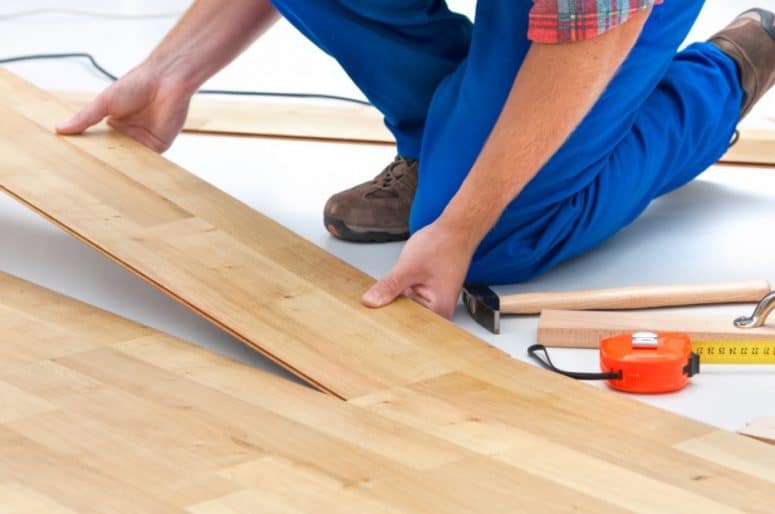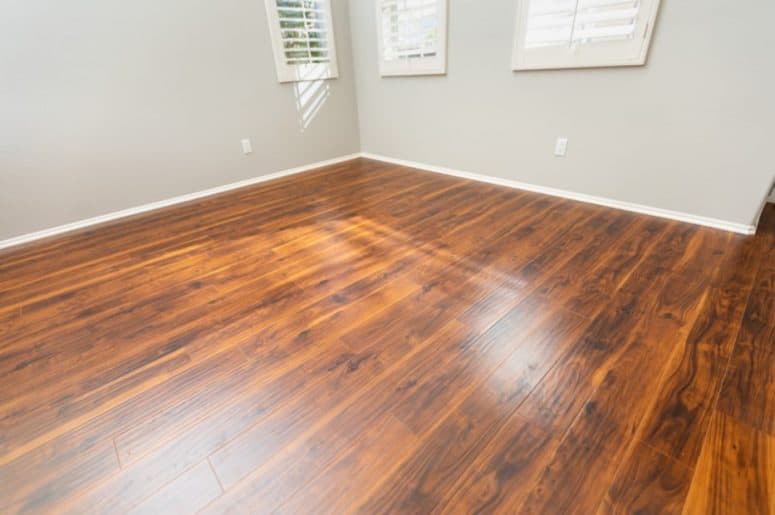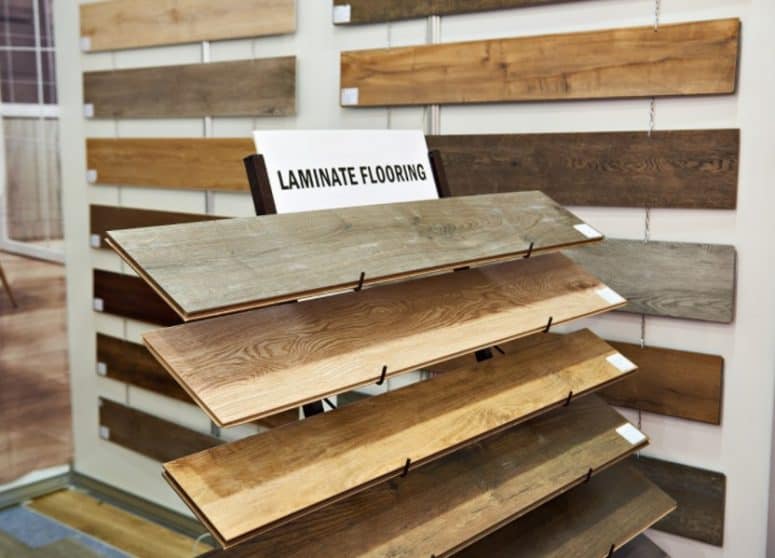When exploring ideas for home decoration, it’s crucial to give proper consideration to the flooring, as it plays a significant role.
Flooring possesses remarkable versatility and has the potential to enhance the overall quality and aesthetic of your room’s design.
With numerous options to choose from, laminate flooring stands out as a highly favored choice among homeowners.
Curious about what exactly laminate flooring is? Wondering about its composition, advantages, disadvantages, and affordability?
Continue reading, and you’ll discover all the answers.
What is Laminate Flooring?

Instead, laminate flooring is crafted by layering plywood or compressed flexible fibers, specifically designed to function as a durable flooring material.
The surface of laminate flooring features a printed photograph protected by a transparent layer of plastic coating. This allows for a wide range of appearances, including wood, stone, tiles, and more.
If you’re considering laminate flooring, you’ll be pleased to know that there’s a wealth of pattern options available. The photographic layer covered in plastic coating ensures that you have ample choices to suit your flooring preferences.
The abundance of patterns also means that you can easily adapt the style of any room, offering versatility in design.
Laminate Flooring Pros & Cons

Now that you have a grasp of what laminate flooring is, it’s important to delve deeper and explore its optimal applications within various rooms of your house.
Understanding the ideal uses of laminate flooring is essential, but it’s equally important to take into account its potential drawbacks. By considering both the strengths and weaknesses, you can confidently determine if laminate flooring is the right choice for your home.
The Pros of Laminate Flooring
Let’s start by exploring the optimal uses of laminate flooring. Unlike hardwood flooring, laminate flooring is highly suitable for rooms with heavy foot traffic.
Feel free to install laminate flooring in your bedroom, family room, or even the kitchen without any concerns.
Another advantage of laminate flooring is its ability to mimic the appearance of wood while offering a more affordable price and easier maintenance.
Furthermore, you have the flexibility to choose patterns that align with your personal preferences and room style since laminate flooring comes in a variety of printed designs.
In addition, installing laminate flooring is a breeze. It features a floating floor system, eliminating the need for nails or glue. It’s incredibly user-friendly!
Another benefit of laminate flooring is its effortless cleaning process. Simply sweeping and mopping the floor will suffice. No need for waxing or resealing. Isn’t that convenient?
Moreover, laminate flooring exhibits excellent water resistance, making it suitable for high-traffic areas.
However, it’s important to note that it is sensitive to excessive moisture, so it’s not advisable for use in laundry rooms or bathrooms unless you want your laminate floor to deteriorate quickly.
These are the positive aspects of laminate flooring. But wait, there’s more to come.
The Cons of Laminate Flooring
Now, let’s carefully consider the disadvantages of laminate flooring to ensure you make an informed decision regarding the best flooring option for your house.
While plastic coatings offer water resistance, laminate flooring is not capable of withstanding prolonged exposure to water. Over time, water can seep into the boards and cause warping between the layers, resulting in a worn-out appearance. Unlike real hardwood, laminate flooring cannot be refinished once it is damaged. Instead, you’ll need to replace the entire laminate floor, which can be time-consuming.
Another aspect to consider is that laminate flooring is sensitive to UV sunlight. If a room receives excessive sunlight, it is advisable to limit direct exposure to the laminate floor. Prolonged exposure to sunlight can cause fading or discoloration of the floor’s color.
While laminate flooring is generally durable, it does have a drawback in terms of noise. The hard surface of laminate flooring tends to produce noticeable footsteps sounds. This may not be ideal, especially if you have children or toddlers in the house.
Considering these factors will help you make an informed decision about whether laminate flooring aligns with your specific needs and preferences.
The Cost of Laminate Flooring

Now, let’s discuss the budget aspect of laminate flooring. When shopping for laminate flooring, you will typically find it available in the form of tiles or planks at stores.
Similar to other flooring options, laminate flooring is typically priced per square foot.
The cost of laminate flooring can range from $1 to $7 per square foot, depending on various factors. If you choose to buy and install it yourself, you will be on the lower end of the price range. However, if you opt for professional installation, you can expect to add approximately $2 to $5 per square foot to the overall cost.
The price of laminate flooring can vary depending on the brand, thickness, and quality of the laminate boards. Thicker laminate flooring may have a slightly higher price tag.
There are several popular brands in the market, including Timbercore, Mannington, Shaw, Mohawk, AquaGuard, and more.
To make the best choice for your house flooring decoration, it’s important to consider all the pros and cons of laminate flooring, as well as its cost, and compare them to other available flooring options.
By carefully evaluating these factors, you can determine the most suitable flooring choice for your budget and desired aesthetic.
Laminate Floor Materials
Contrary to popular belief, laminate flooring is not solely composed of laminated wood. While it does contain wood materials in its layers, there’s more to its construction.
The foundation of laminate flooring consists of pressed chipped wood particles, forming the base layer. On top of this base, the flooring is designed to resemble real wood, mimicking its appearance.
However, the realistic wood effect is achieved through a combination of aggregated wood particles that are compressed to form sheets, providing support to the upper layer of the laminate flooring.
The crucial component that ensures durability is the clear coating, which acts as a protective barrier. This thin wear layer serves as a shield against various external elements, including moisture, UV rays, and scratches.
Laminate flooring typically comprises four distinct layers: the wear layer, design/image layer, core layer, and back layer. Each layer has a specific purpose and is fused together using high heat and intense pressure during the manufacturing process.
Here is a breakdown of the layers in laminate flooring and the materials they are composed of.
Wear Layer
At the topmost layer of laminate flooring lies the wear layer. It is crafted using aluminum oxide, a robust material that safeguards against fading, stains, and surface burns caused by high temperatures.
Comprising two transparent, resilient plastic sheets, this layer acts as a protective barrier, effectively shielding the laminate flooring from scratches caused by pets or sharp objects.
Image Layer
Beneath the wear layer, the laminate flooring features the image layer, also known as the design layer. This layer is responsible for the visual appearance of the laminate floor.
The design layer consists of a high-quality printed photograph that accurately replicates the desired look, whether it’s the appearance of wood, stone, or any other chosen design. The level of detail is so precise that even upon close inspection, the image retains a remarkably realistic appearance.
Base Layer (Core)
Situated beneath the image layer is the core layer, often referred to as the base layer. It earns its name due to its crucial role in providing durability to laminate flooring.
The core layer is composed of a high-density board made from a composite of wood chips. It serves as the foundation beneath the wood grain photograph, lending stability and strength to the laminate flooring. However, it’s important to note that this layer is still susceptible to water damage.
While the base layer exhibits a certain level of water resistance, it is not impervious to prolonged exposure to moisture. If water is not promptly dried, the base layer may not effectively withstand the potential effects of water damage.
Back Layer
The back layer of the laminate flooring plank plays a crucial role in its installation and protection.
This layer serves as the bottom part of the plank and ensures a flat surface for proper installation. It helps in achieving a stable and level flooring base.
Furthermore, the back layer acts as a protective barrier, safeguarding the plank from excessive moisture. It helps to prevent moisture from seeping into the laminate flooring, which can lead to damage or warping over time.
What Is Laminate Floor Good for?
Laminate flooring is highly durable and capable of withstanding various challenges, such as pet scratches, water spills, and heavy foot traffic.
While it can handle water spills and moisture to a certain extent, it is not suitable for installation in consistently wet areas like laundry rooms or bathrooms. Although it performs better than hardwood flooring in terms of water resistance, the core layer of laminate flooring has its limits in holding water for extended periods.
However, when it comes to exposure to sunlight, laminate flooring is perfectly fine. This is due to the protective double sheets coating on the top layer of the laminate flooring, which helps to shield it from the effects of sunlight.
Do I need Subfloor / Underlayment?
When choosing flooring options, it’s important to take into account the subfloor and underlayment requirements. The same goes for laminate flooring.
For laminate flooring to be properly installed, it requires a solid and level subfloor. To enhance comfort and reduce noise, a foam or felt underlayment is typically placed between the subfloor and the laminate flooring, creating a buffer that separates the two surfaces and offers a softer feel when walking.
In cases where the subfloor is not in optimal condition, a thin plywood underlayment may be added on top of the subfloor, before installing the foam underlayment. This additional layer helps to address any irregularities in the subfloor and provides a smoother base for the laminate flooring installation.
How Durable is Laminate?
Laminate flooring is known for its exceptional durability, thanks to its composition of four layers within each plank. It can withstand scratches, sharp objects, and minor water spills quite well.
Moreover, it is suitable for installation in high-traffic areas, making it ideal for households with active lifestyles, as it can endure various activities without causing disruptions or damage to the floor.
However, there are instances when laminate flooring may not exhibit the same level of durability. While it can handle moisture and water to a certain extent, it is important to address any spills or excess moisture promptly. If water is left standing for an extended period, the core layer of laminate flooring may not be able to withstand the absorbed water, potentially leading to damage. Therefore, it is crucial to provide proper care and maintenance to ensure the long-term durability of laminate flooring.
Laminate Flooring Maintenance
Maintaining the pristine condition of your laminate flooring requires proper care, but the good news is that it is relatively easy to clean and treat. Laminate flooring is designed to withstand moisture and temperature changes caused by sunlight exposure.
You can effortlessly keep your laminate flooring looking fabulous by sweeping or vacuuming it regularly to remove loose dirt and debris. If more thorough cleaning is needed, you can safely mop the floor using a damp mop with a suitable amount of water. With these simple steps, your laminate flooring will maintain its gorgeous appearance.